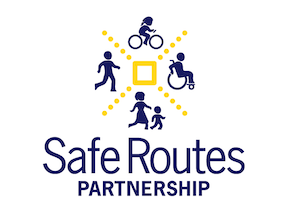Last week on October 5th, thousands of kids, parents, teachers, and community members participated in the 20th Anniversary of International Walk to School Day.
Resource Library
Key takeaway:
- Performance measures directed toward bicycle and pedestrian travel modes are key for evaluating and advocating for active transportation infrastructure and programs.
Key takeaway:
- Almost half of children live in communities with policies for land use development incentives to promote active living, but there are disparities in these policies by rural/urban locale.
This report is a biennial update on national trends related to walking and biking across the United States, active transportation participation, safety, infrastructure, policy, and funding support. This report is intended to promote access to data, measure progress, support policy and advocacy efforts, and connect to health initiatives.
Key takeaway:
- Few children live in areas with policies promoting active transportation to school, with community income level and geography (rural vs. suburban/urban) influencing the likelihood of being covered by certain policies.
This webinar, part of the CDC's Health Impact in 5 Years initiative, is an excellent opportunity for Safe Routes to School advocates to learn how to pitch Safe Routes to School to health partners.
This curriculum was developed to be used in physcial education classes for all grades in Arkansas. The curriculum is aimed at rural communities and includes outlines of different lessons, activities, and all of the materials a teacher would need to implement bicycle and pedstrian safety education.
KEY TAKEAWAY:
- The long-term health benefits of physical activity through active travel generally outweigh the health risks of air pollution.
This paper reports findings from The Near Miss Project, the first-ever UK study of cycling near misses—incidents that don’t result in an injury but were nevertheless scary, annoying, and/or stressful—of 1,500 cyclists.
In September, the Federal Highway Administration (FHWA) issued a new Strategic Agenda for Pedestrian and Bicycle Transportation, which will guide their spending and initiatives for the next five years.
Guest blog post written by Karen Mohr, Principal, Beryl Heights Elementary School, Redondo Beach, CA.
To become one of America’s Healthiest Schools, it simply takes one step at a time.
In this study, increases in perceived safety were associated with increased recreational walking, but not walking for transportation.
Key takeaway:
- As driver speed increases, the rate of yielding to pedestrians decreases.
- The researcher suggests that speed enforcement and design to reduced speeds through skinny lanes or traffic calming devices could improve unsafe crossings.
Data on crashes involving school-transportation vehicles provides important insights for safety in school travel across motorized and nonmotorized modes.
This infobrief describes state outreach, technical assistance, and partnership approaches that support rural communities and highlights two communities that have successfully used federal funds to improve safety and accessibility for walking and bicycling.
Please join the Safe Routes Partnership in asking our next President to make a significant investment in getting Americans more physically active. Half of adults and 75 percent of children in this country do not meet the minimum levels of physical activity recommended for good health. Yet, the US Centers for Disease Control and Prevention (CDC) currently has very little funding to address our nation’s physical inactivity crisis.
This study describes relationships between travel for different transportation modes and aspects of the built environment. These relationships can be used to forecast changes in driving, walking, or transit use and estimate impacts of policy changes that influence the built environment.
Measuring the built environment can help assess needs and set priorities for creating healthy community design.
Qualitative interviews with an adult population indicate that concepts of neighborhoods and walkability apply to rural areas, but some characteristics of these concepts may be different from urban and suburban areas.
KEY TAKEAWAY:
- In this study, urban location and decreased distance to school were related to adopting or maintaining active transportation to school.

